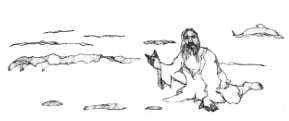04: The Jonah Saga – Lesson Plan
Key Thought : Relying on our own wisdom and inclinations is a poor way to approach mission. Only through submission to God’s leading can we understand His plan and our role in it..
[Lesson plan for The Jonah Saga July 18-24, 2015]
1. Have a volunteer read 2 Kings 14:25, Jonah 1:1-3.
 a. Ask class members to share a thought on what the most important point in this text is.
a. Ask class members to share a thought on what the most important point in this text is.
b. What do these verses tell us about Jonah – both good and bad?
c. Personal Application: Do we tend to look at the negative aspects of our church leaders too much, or do we excuse them because of the good work they do? Share your thoughts.
d. Case Study: One of your relatives states: “This is like sending a Seventh-day Adventist to a large Jihadist city in the Middle East and asking him to preach to the Muslim extremists to repent or they will be destroyed by Jesus Christ. Who would do such a thing?” How would you respond to your relative?
2. Have a volunteer read Jonah 1:9,14-17.
a. Ask class members to share a short thought on what the most important point is in this passage.
b. Jonah admits he is a Hebrew and fears the Creator God, but he is running from God’s call. How did his confession of faith and punishment influence or affect the sailors?
c. Personal Application: What steps can we take to overcome a sense of exclusiveness or self- centeredness in our spiritual lives? Share your thoughts.
d. Case Study: One of your friends states, “So Jonah had converts to the Lord while running away from his call to mission. Some would say it was the Lord’s will that he fled to bring more people into the faith. Just like some people say that the Lord intended for them to be out of the church for a season to be able to witness to people he wouldn’t have otherwise hung around with.” How would you respond to your neighbor?
3. Have a volunteer read Jonah 3:8-10, 4:1.
a. Ask class members to share a short thought on what the main idea of this text is.
b. Why do you think the Ninevites believed the words of Jonah and repented in sackcloth and fasting?
c. Personal Application: Do we tend to be more interested in our own trivial personal interests than the lost souls whom Christ has shed His blood to save? Share your thoughts..
d. Case Study: One of your neighbors states, “How does it feel to know if you are in the right place, doing what God wants you to do? Are you living where God wants you? Are you doing what He has called you to do?” How would you respond to your friend?
4. Have a volunteer read Jonah 4:9-11.
a. Ask class members to share a short thought on what the main idea of this text is.
b. Why did Jonah wish to die because the Ninevites repented and the gourd withered?
c. Personal Application: How can we develop the same love, compassion, and empathy on angry, rebellious, ignorant people that God has for them? Share your thoughts.
d. Case Study: Think of one person who needs to hear a message from this week’s lesson. Tell the class what you plan to do this week to share with them.
(Note : “Truth that is not lived, that is not imparted, loses its life-giving power, its healing virtue. Its blessings can be retained only as it is shared.” Ministry of Healing, p. 148)
